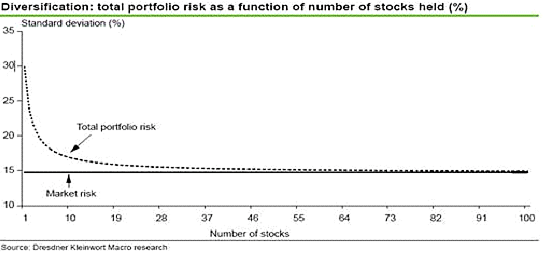When Goldilocks was roaming through the forest she was hungry and came across three bowls of porridge. The first one she tried was too hot. The second one she tried was too cold. The third one was just right.
When we look at our investment portfolio of businesses, how many is too many, how many is too few, and how many is just right?
A few things to consider.
The main goal of diversification is to limit our downside. This is largely measured by reducing unsystematic risk, or firm-specific risk. The next question you might ask is, how many stocks do I need in my portfolio to sufficiently reduce unsystematic risk? Virtually every investor wants to create higher returns while lowering the risk of any individual investment.
The benefits of concentrated portfolio returns can be demonstrated in a simple math exercise.
Consider two portfolios. The first is constructed of 100 public equities equally weighted across sectors, industries and geographies. If one stock in this portfolio loses 10%, the portfolio only goes down 1/10th of 1 percent(10 basis points). The upside is similar.
But…if the portfolio only has 10 stocks and one loses 10%, the portfolio goes down 1%. Similarly, the portfolio return increases by the same if the stock goes up 1%. This is all simple math as the return is proportionate in both cases to the size of the portfolio.
This only gets exciting or worthwhile when we look at finding 10 baggers (10x stock returns).
The likelihood of finding 10 baggers is rare—and much has been written about this. If we’re lucky to get one in our portfolio of 100 stocks, we only get a 9% return.
But….if our portfolio of 10 stocks gets a 10 bagger, we net a return of 90%!
For this reason, Andrew Carnegie once mentioned “Put all your eggs in one basket—and then watch that basket!”
The following well-publicized graph shows that with a portfolio of 12-15 public equities, we get 90% of the benefit of diversification. In other words, if we continue to add more stocks to our portfolio, we’re not significantly reducing portfolio risk(standard deviation).

Of course, we can’t just measure portfolio risk by standard deviation. That’s a blog post for another day!
When we think of limiting downside and managing risk we often forget to associate the time horizon. It’s easy to get scared over a month or even during a year or longer when markets can be volatile. Keeping this in perspective with long-term returns will help us remember the market always has volatility and swings.
Some might say, “12-15 stocks is way too concentrated for me.” Fair but remember to keep this in perspective. When we bought a home, did we check the market value a month later? When you got married, were you worried about your spouse leaving a week later? Most of us have one current employer. We are already concentrated in many facets of our life. We try to control risk as we make these decisions and it should be no different with investing.
What makes us afraid of “putting all our eggs in one basket”? Our fear of losing. This is explained by loss aversion or negativity bias. We naturally are more afraid to lose money than the opportunity to make an equal gain.
Warren Buffett is famous for saying “Diversification may preserve wealth but concentration builds wealth”.
What’s important here is not overly diversifying so that our winners get diluted by underachievers.
Photo credit: First Round Review

